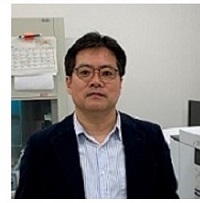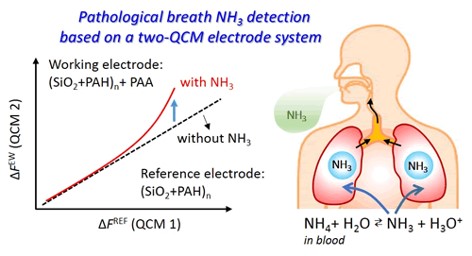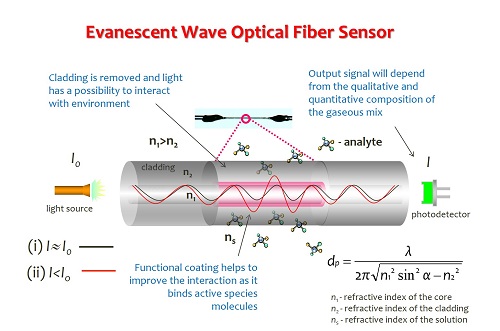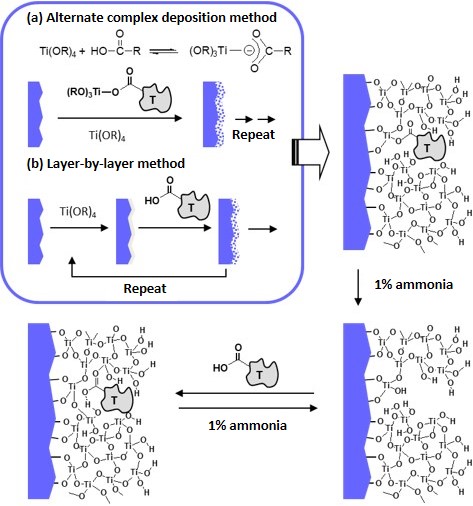Our research interests
Overview

Prof. Lee's research interests are on materials chemistry based on self-assembly of organic/inorganic nanohybrids, molecular imprinting using metal oxide or hybrid thin films and nanoparticles, and chemical sensing for biochemical applications. Lee has published in excess of 100 peer reviewed conference and journal papers, 10 book chapters, and one book in these areas and got patents more than 27 since 1999 besides plenty of domestic and international conference presentations. Special concerns over the past 20 years regarding the biological influences of chemicals in the environment have led to the necessity for rapid evaluation of pollutant levels in various areas. Fast detection and monitoring of toxic compounds related to environmental pollution have required the development of various portable sensors with sufficient sensitivity and long-time stability. Combination of devices and materials that enable realistic sensing performance with high sensitivity and selectivity is one of the challenging topics for sensor fabrication. So far, for this purpose he has collaborated with a number of research and industrial teams both within Japan and internationally. Recently, he has started several new projects for medical diagnosis based on small molecular cancer biomarkers including volatile organic compounds (VOCs) excreted from human body and cells. Plenty of molecular information obtained in this study would be useful for noninvasive disease diagnosis and the development of smart sensor devices for point-of-healthcare.
Latest information
10/12/2018
[Press release] Invention of an oral cancer diagnostic technology based on the GC-MS analysisi of odrous salivary metabolites
Our recent study found 27 odorous organic metabolites that were specifically identified from saliva, which can be divided into three groups, named such as "disappeared," "increased or decreased," and "newly produced." Among them, 12 compounds could be finally used for noninvasive diagnosis and early detection of oral cancer, namely providing a new diagnostic technology to quickly diagnose the presence or absence of oral cancer from the fluctuation of volatile organic metabolites in saliva. (Japanese Patent Application No. 2018-205844, October 31, 2018; Journal of Chromatography B 1104, 49-58, 2019).
Video broadcasted by TBS Asa-chan! on December 17, 2018.
Laboratory skills
6. Elucidation of disease odor (2006〜, oral cancer study started in 2013)
In 2017, the annual number of deaths from cancer (malignant neoplasms) in Japan exceeds 370,000, and early detection of cancer (early diagnosis) is one of the most important issues in recent medical area. Positron emission tomography (PET) is the most focused approach as a tool for early detection of cancer, but there are still some problems such as safety of contrast agents administered to the body, diagnostic cost, and accuracy of diagnostic results. On the other hand, biomarkers have widely been used to evaluate physiological or pathological processes and pharmacological responses (for instance, DNA, mRNA, proteins, various substances involved in angiogenesis, neurotransmission or hormone action). Interestingly, it is well known that volatile organic compounds excreted from the human body are closely related to various diseases including cancer, reflecting the status of the human body health. On the other hand, detailed information on volatile metabolites is strongly required to elucidate the relationship between disease and odor, and gas chromatograph-mass spectrometer (GC-MS) that is employed in this study is the most suitable equipment for this purpose.

Figure. Schematic of identification of volatile organic metabolites emitted from human body as a chemical plant.
Video showing a flow of biomarker extraction from biological samples and GCMS analysis
5. Direct breath analysis without pretreatment (2015〜)
In recent years, a broad spectrum of volatile organic substances (VOCs) in breath have been reported to be related to several diseases, and they are expected to be used for early detection and prevention of diseases. Disease diagnosis based on breath odor discrimination has a long history. Recently, pathological examinations using a dog have been reported in several studies on skin cancer, bladder cancer, lung cancer, and breast cancer. Generally, human breath contains hundreds of mixtures in the concentration range of ppb to ppt, and recent researches have revealed that some of them show high correlation with specific diseases. At present, breath analysis is applied to limited tests such as bacterial reproduction and infection with H. pylori, and there are few examples applied for diagnosis of specific diseases. This is because it is difficult to accurately analyze VOCs due to their presence in a wide range of environment and their their complexity as a mixture with water, especially which interferes the detection of VOCs in sensors or analytical devices. It is well known that ammonia, one of the smallest volatile metabolites that are released from the body, can be an important biomarker closely related to liver or kidney disease. Recently, we proposed a quartz crystal microbalance (QCM) sensor system that is able to directly detect a trace level of ammonia contained in exhaled high-humidity breath. To the best of our knowledge, it is the first trial in the world, and now we are aiming for its practical use as a medical device.

Figure. Quartz crystal microbalance sensor system that can directly detect a small amount of ammonia contained in exhaled breath.
4. Biochemical fiber optic sensors (2008〜)
The evanescent wave that is generated on the near the surface of the fiber core is usually very weak; however, it can be amplified by removing the cladding of the optical fiber and used for chemical sensing by chemically modifying the core surface. Interference between the evanescent wave and the environment on the surface of the fiber core results in changes in optical properties such as refractive index and light absorption. For example, when a chemical such as a dye that absorbs the light adheres to the fiber core, the light absorption of the substance at a specific wavelength is reduced. Using such a principle makes it possible to easily measure the presence or changes in concentration of the target molecule.

Figure. Schematic of chemical detection based on the using evanescent wave that leaked from the core of an optical fiber.
3. Top-down sol-gel process (2015〜)
Conventional sol-gel methods use metal alkoxides as precursors, and produce the target metal oxide via hydrolysis and condensation reaction of the metal alkoxides. However, this new top-down sol-gel process can be achieved by using NH4TiOF3 in the forms of single crystal or bulk powder with micrometer sizes as metal oxide precursors. In particular, this process can be employed for uniform coating of titanium oxide on the surface of nanocarbon materials, which provides a useful synthesis route for the design of functional nanocomposite materials.

Figure. TiO2 complexation with nanocarbon materials by the top-down sol-gel process.
2. Gas-phase surface sol-gel process (2006〜)
The surface sol-gel process is useually achieved by immersing a reactive substrate with hydroxyl groups on the surface in a metal alkoxide solution. The physically adsorbed metal alkoxides are removed by washing the substrate using organic solvents, and then hydrolyzed in water. A thin film of nanometer thickness can be formed by multifully repeating the deposition cycle. In particular, various metal alkoxides can be used, and independent structural control can be performed in individual layers, enabling complexation with various metal oxides or organic and inorganic components such as polymers, proteins, and metal noanoparticles. From the viewpoint of improvement of the surface sol-gel process, our group has proposed a new surface sol-gel method that is based on the use of gas phase metal alkoxides. This method has a technical advantage to make precisely layer-controlled nanothin films composed of metal oxides or organic/inorganic composites without using organic solvents.

Figure. Fabrication of TiO2 films via vapor phase surface sol-gel deposition: (A) Complexation with protein and (B) example of Ag micropatterning.
1. Molecular imprinting technique (1996〜)
Our molecular imprinting technique based on metal oxide nanothin films has been approached by two types of fabrication methods since 1996. One is based on the alternate complex deposition method, and the other is based on the layer-by-layer method. Our first molecular imprinting study that was tried using titanium dioxide was published in Langmuir, which is a specialized journal of the American Chemical Society (ACS) (Langmuir 1998, 14, 2857-2863), has been cited in several studies so far.

Figure. Schmatic of fabrication concept of molecularly imprinted thin films by the surface sol-gel process.
Overseas joint researchers

| Name | Serhiy Korposh |
|---|---|
| Position | Associate Professor, Dr. |
| Affilation | Department of Electronics, Nanoscale Bioelectronics and Biophotonics, Faculty of Engineering, University of Nottingham |
| Research interests | Fibre optic sensors, functional materials, molecular imprinting, bio-markers detection Click here for details |

| Name | Stephen Morgan |
|---|---|
| Position | Professor, Dr. |
| Affilation | Biomedical Engineering, Faculty of Engineering, University of Nottingham |
| Research interests | Optical techniques for imaging and spectroscopy of tissue using techniques, development of optical devices to monitor the microcirculation for applications Click here for details |

| Name | Stephen James |
|---|---|
| Position | Professor, Dr. |
| Affilation | Applied Optics Centre for Engineering Photonics, Cranfield University |
| Research interests | Optical instrumentation and photonic sensors, with an emphasis on their practical deployment. Areas of particular interest are: Optical Fiber Sensors, Fibre Bragg Gratings, Long Period Gratings, Interferometry Click here for details |

